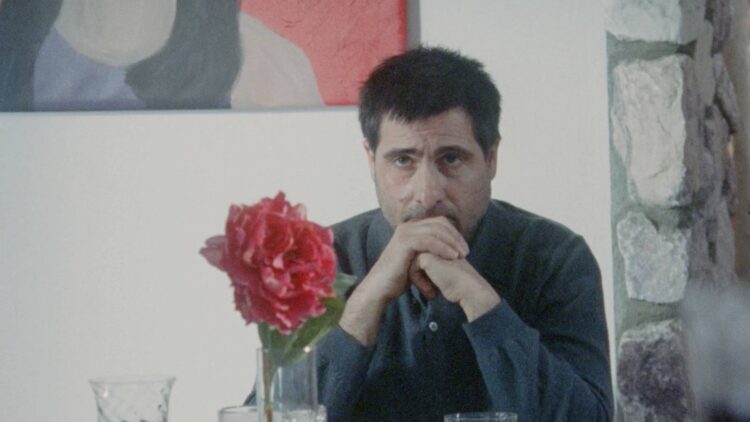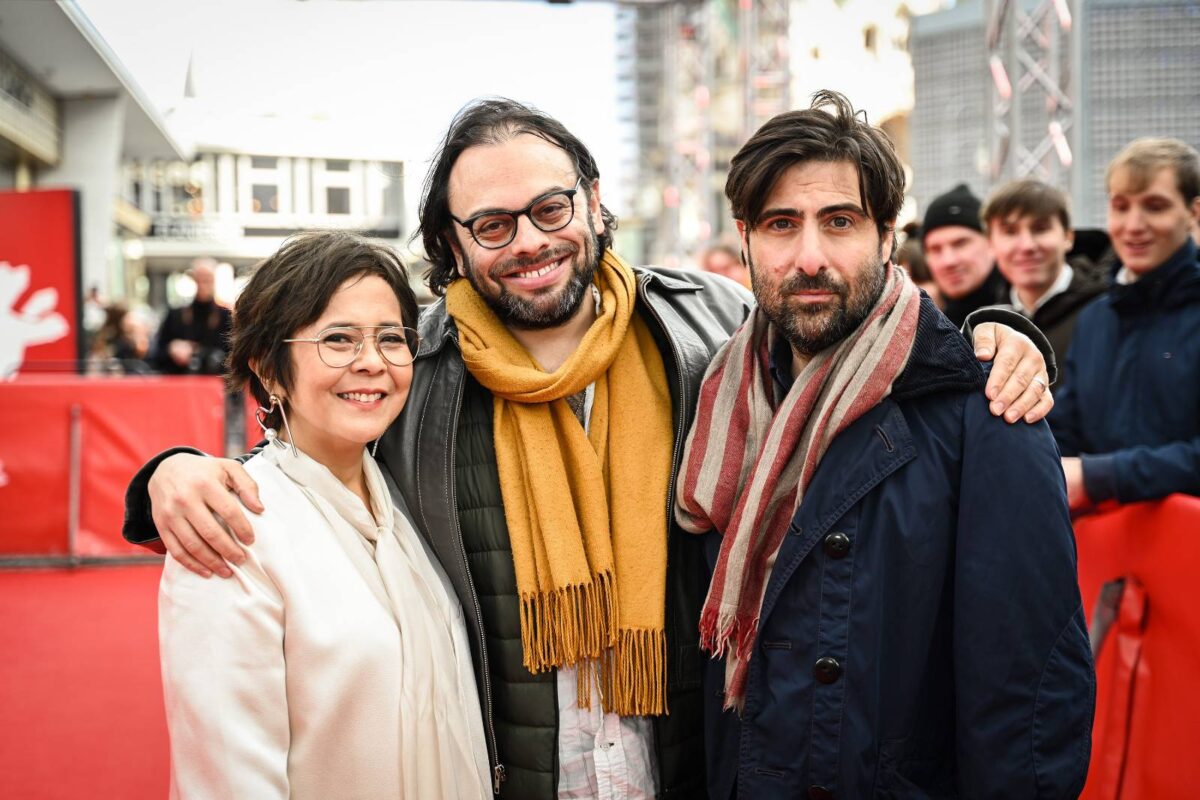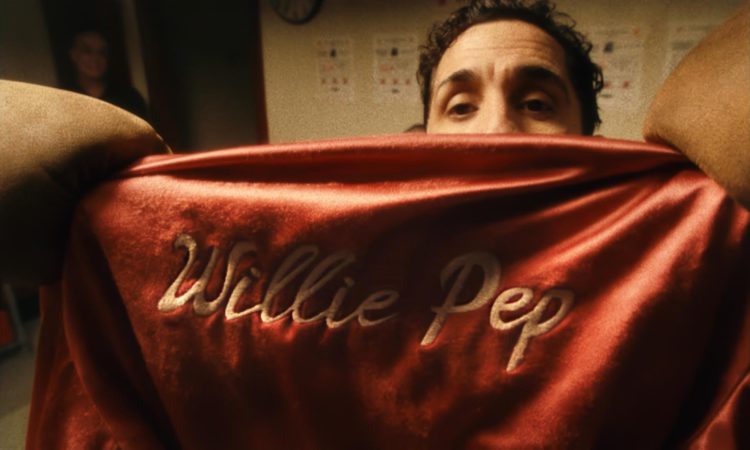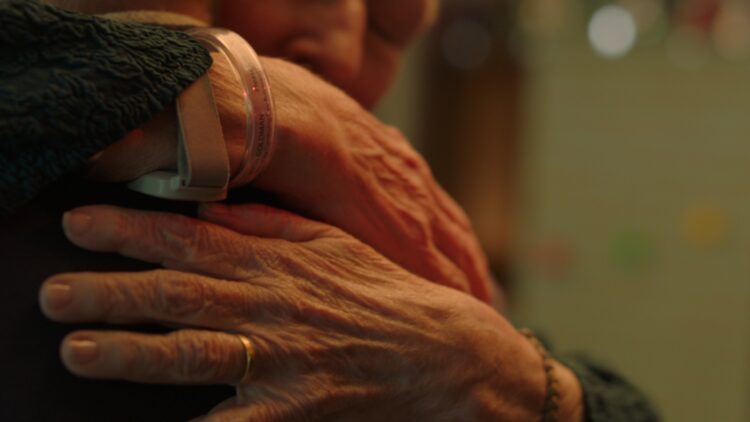

Nathan Silver’s Between the Temples takes a stock story––a lonely middle-aged man finds unexpected love––and places it in an unfamiliar context. For one thing, it’s set in the upstate New York town Rhinebeck, depicted as a place where social life revolves around a bar and golf course. Cantor Ben Gottlieb (Jason Schwartzman) can barely bring himself do his job, suffering a crisis of faith following his wife’s death. He’s lost his voice, literally and figuratively. Driven to suicidal ideation, he lays down in the street at night and hopes to get run over by a truck. He visits a priest for a discussion about his shaky faith. Although he’s on friendly terms with his boss, the temple’s rabbi (Robert Smigel), and his two lesbian mothers, he drinks to cover up his sorrow.
Carla (Carol Kane) comes into his life when she decides, in her 80s, that at long last she wants to get her bat mitzvah. (Her character was inspired by Silver’s mother Cindy, who had been a regular actor in his work.) She had been Ben’s music teacher when he was in elementary school, helping teach the skills he’s used professionally and with which he now struggles. As often happens in Silver’s films, everything comes together over a chaotic dinner scene, edited from two days’ shooting with varying degrees of improvisation.
Shot by Sean Price Williams, Between the Temples employs rapid-fire, extremely tight close-ups, but the style isn’t abrasive. His 16mm cinematography also brings out a warmth. While Silver is no longer making a low-budget film annually, as he did from 2012 to 2019, his work’s balance of edge and heart remains.
Shortly before its release in U.S. theaters, I spoke with Silver via Zoom.
The Film Stage: Jason Schwartzman’s first film was Rushmore, shot when he was 18. There’s been an arrested adolescence to his image since then. This is the first performance where he really seems like a middle-aged man. How did you and him dig into the character to bring it out?
Nathan Silver: We had discussions for a year-and-a-half, before we went into production, about who this person was. He’s at the end of his rope, at a crossroads. It’s a crisis of faith, not a midlife crisis. For Jason, the key was talking about David Berman of the Silver Jews. What would Berman look like if he were a cantor in a small town in upstate New York? That unlocked the person you see onscreen. He loved Berman’s music, and at that time he was listening obsessively to his last record, Purple Mountains.
There’s not much vanity to Schwartzman’s performance. A lot of the camera angles used to shoot him are pretty unflattering. Was that worked out in advance?
There was an understanding regarding that. At the time, he said he wanted to look and feel the part. The camera was there to capture that. He just walked by outside! [Laughs]
Did you consider working again with your mother on this?
At first there was an iteration with her playing Carol Kane’s character, but we wanted someone the audience would recognize from their youth, like they’d recognize Schwartzman. We thought it would be lovely to make the audience remember her as soon as she appears onscreen.
Is this the first film you’ve shot on 16mm?
It is. Actually, it’s the first one I’ve shot on film in 15 years. My first feature was shot on 35. It was a disaster because of the cost. We lost days of shooting. I knew I wanted to shoot on film to reflect Carla’s spirit, which is warm––not the cold look of HD. I also wanted the flexibility to shoot as much as I wanted without worrying about the cost.
How different was it to shoot on film, compared to all the films you made on DV?
We had two cameras for the Shabbat scene, shot over two nights. Hearing the sound of the camera was so delightful. There’s something comforting about that. Beyond that, it didn’t really change my process. I shot the same ratio as I did on DV.

Dolly de Leon, Nathan Silver, Jason Schwartzman at Berlinale 2024.
Were you familiar with the area in upstate New York before you searched for locations?
Yes. We actually shot at my parents’ temple. They moved from Boston to Rhinebeck 10 years ago. I had no real knowledge of the area before that, but obviously I’ve spent some time there. It’s all over the place, going from beautiful landscapes to closed-down factories; there’s a mix of beauty and despair. You never know what you’re going to get from town to town. That was a propos to the themes, so it felt like the right setting. I also wanted to shoot in my parents’ temple because they have these honeycomb stained-glass windows, which are very beautiful.
You’ve been working with Chris Wells and Sean Price Williams since the mid-2010s. How has your process with them evolved?
I’ve now written many scriptments with Chris. We have this process we call “circling the drain”: we come up with ideas and think about them endlessly ’til we have a version we think is sound. Chris is not attached to anything; he looks at the movie as a whole, rather than identifying with any details. With Sean, I adore his sensibility. It’s like having another actor on set. He’s very much present for whatever happens in the reality of the production. Instead of trying to get everything right, he’s wonderful at reacting spontaneously.
Do you find it valuable with people who’ve directed films themselves, like Williams and your editor John Magary?
I love working with other directors. The whole idea is that you’re putting together a group of people whose sensibilities are aligned with yours and that you admire.
How did John get cast as the guy who punches out Jason?
Sean and John are both 6’ 5”. Sean had to be behind the camera, so it couldn’t be him. It had to be John. He pointed out that it was such a pivotal moment that he couldn’t be edited it even if I asked him to.
I’ve been pleasantly surprised to see ads for the film on bus stops in New York. How did going from working with Factory 25 to Sony Pictures Classics change things?
Sony actually bought it out of Sundance; they really took to it and put their weight behind it. Factory 25 is owned by Matt Grady. He’s a close friend of mine and a mentor. Working with Sony means that this is my widest release so far, but the same spirit went into it as all my other films. Matt wrote to me about how happy he is to see those ads all around.
Depictions of Jewish life in American cinema tend to pass through comedy, which Between the Temples does to some extent, but they also tend to be fairly secular. It feels like there are few American films about someone who is this involved in a religious Jewish community. Was that aspect particularly important?
Chris and I were interested in the life of a cantor and what that looks like. We started with the idea, “What if a cantor can’t sing when that’s his job? What does it look like? Is it like being the rabbi’s vice president?” Even though I was raised in a secular Jewish household, my parents’ best friends are Orthodox. This was a way of learning. Chris and I have written scripts about the opera, though I’d never seen an opera till a few months ago, and a casino; I’ve never gambled. I find learning about these worlds fascinating. It’s like going back to school.
Back when you made a film every year, which you did for seven years, how much of your life did that take up? I’d imagine that had to be incredibly time-consuming.
That was my life, along with odd jobs and trips to the film-festival circuit to try and raise financing.
There was a five-year break between your last film (the 40-minute short Cutting My Mother) and Between the Temples. Did you have another project planned that COVID got in the way of?
Yes, there was a movie I had in development with David Gordon Green’s company. Unfortunately, it fell apart due to COVID. The movie about opera kept on dragging for various reasons. I was working on this one as well, but it actually happened. In filmmaking, you never know what’s going to happen, so I embrace the unexpected.
You can see a lot of that chaos in the framing. How close did the camera get to the actors?
Very close. The actors often said they felt like Sean was another actor in the scene.
Do you think about filmmaking differently now that you’re not making low-budget films so quickly? I’d imagine there would be a point where that’s no longer sustainable. People either stop making films or get hired by Netflix and lose whatever was personal about their work.
It isn’t. I got burnt out because I had to make money on top of that. I had two jobs, teaching on top of filmmaking. When you’re doing that as well as working on all these films, you have no life. I’m now married. I see a path forward and I just hope that it’s not cut off. Writing multiple scripts at once allows me to be ready for the moment. The industry is in a very strange place. I don’t know what the future holds; I can only hope that there’s hope. It’s always a gamble what I will have a chance to make.
Between the Temples opens on Friday, August 23.
The post A Crisis of Faith: Between the Temples Director Nathan Silver on Jason Schwartzman’s Inspiration and Shooting on 16mm first appeared on The Film Stage.



